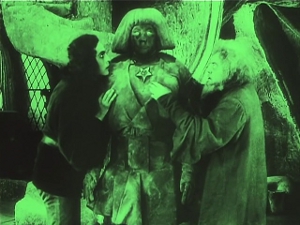
Any student of horror stories will tell you messing with otherworldly forces is a bad idea and it’s an idea that’s been with us since the birth of film. Thomas Edison himself – or his film company, at the very least – produced the first adaption of Frankenstein in 1910. Like half the movies made before 1950, that sixteen minute film was thought lost until the mid-70s. But we’re not talking about that Frankenstein, or the 1915 adaption with the copyright-dodging title Life Without Soul. Today we’re going back to Weimar Germany and the twisted, medieval world of Expressionism.
Mary Shelley brought a lot to the table when she sat down to write her tale of a mad doctor and the life form he created but refused to take responsibility for, manufacturing his own tragedy. That basic outline’s formed the backbone of tall tales from around the world: the Hero who seeks to do Good but ends up doing Evil because he thinks ends justify means. Among them you’ll find the legend of Rabbi Judah Loew ben Bezalel of Prague, who, at some point in the late-15th century, created a golem to defend his ghetto from the latest round of antisemitic expulsion edicts.
No matter who, what, or where you are, there’s always going to be some asshole looking at your ghetto and seeing prime real estate…if only those damned “undesirables” would stop living on it. The idea of creating a communal defender, unbiased by human desire or prejudice, is far from exclusive to any one set of circumstances. But the Golem of Prague entered into legend by turning against its creator and going on a rampage. This was either due to an inherent design flaw…or to the golem making that Big Mistake most homunculi make and falling in love with a human woman who didn’t return his affections. Either way, Rabbi Loew defeated his creation, with either returned to dust and found itself stored in the attic of Prague’s Old New Synagogue, ready to be reanimated should the need ever arise.
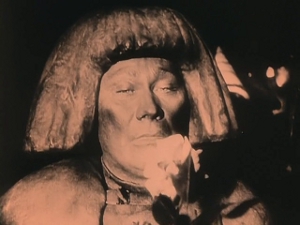
German filmmaker Paul Wegener heard this story around 1913 while shooting his The Student of Prague on location. Modernizing the tale, he made a movie called The Golem in 1915…which really is lost, probably forever. As is its short, comedic sequel The Golem and the Dancing Girl. But that’s okay: Wegener apparently wasn’t happy with how The Golem turned out anyway. So after World War I and the economic hardships that came with, Wegener wrote, directed and starred in this…which we’d now call “a prequel.” But don’t hold that against it. At least Wegener went to the trouble of making an entirely new film when he could’ve sat back and just re-released the previous one with “updated” special effects. Hell, that way, the original might’ve actually survived. Adulterated or not, at least we’d have some part of it.
How He Came Into the World is a period-piece adaption of the legend as Wegener originally heard it…more or less. It’s a good movie very few have ever heard of, much less seen, and deserves to be enjoyed by more than a small collection of classicists (like me, Your Humble Narrator). A shinning example of its form, with production design and photography easily matching its more famous sibling, The Cabinet of Dr. Caligari, this Golem‘s not without its problems…but what isn’t? Even Nosferatu could’ve used some judicious editing.
It begins, not in ourselves, but in the stars, which inform Rabbi Lo(e)w (Albert Steinrück) of impending doom for his “medieval” community. The usual mass prayer and chest-beating ceremonies have as much impact as you’d expect them to have and soon the decree comes down from the (fictional) Emperor Luhois (Otto Gebühr): all Jews must vacate the ghetto before the next new moon. The “or else” is left implicit, and based on Luhois’ obvious historical inspirations I can tell you it usually involved armies of rapist mercenaries – the only real armies anyone could field at the time.
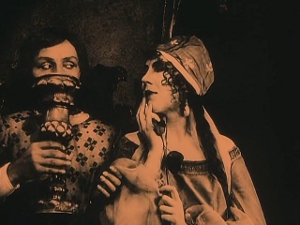
Desperate, and seeing that the location of Venus favors an invocation, Rabbi Low begins sculpting a golem out of his home’s muddy basement wall before the bad news even arrives. Delivered by the Emperor’s Knight/Currior Florian (Lothar Müthel), it’s little more than a spur. Rabbi Low cut open the magic seal on his secret basement door before Florian even left the palace. The stars told him disaster was coming, and so he acts…but from my cynical, 21st century perspective, I can’t help wondering what might’ve happened if the stars had said something else. In my opinion, this film qualifies as a Frankenstein story because the protagonist sets out with largely self-less goals. Both Rabbi and Doctor want the same thing: to prevent death. They go about it by creating life…which is Not Good…but neither man sets out to make monsters so much as tools. To help people escape death. And if that ain’t noble, I don’t know what is. That’s the tragedy.
In any case, Florian arrives and falls in instant love with Rabbi Low’s hot daughter, Miriam (Lyda Salmonova). The feeling seems mutual, and Rabbi Low’s smart enough to avoid crushing a courtier’s hopes. Instead, he reminds Florian who it was that once drew up personal horoscopes for His Imperial Majesty, and that the name starts with “R” and ends with “abbi Low.” One Act Break later, Florian returns with a invitation to the upcoming Rose Festival, showing Prague and Portland, Oregon have more in common than I ever thought. The Emperor hopes Rabbi Low will “amuse us with your magics.” Rabbi Low hopes to talk the Emperor out of his expulsion edict. Know what could kill both those birds? A golem.
This makes much more sense than creating a man of clay to protect you from an armed mob or avenge you once you’re dead. Initially, I feared Rabbi Low might create it as a low-tech home security system…or a high-tech chastity belt for Miriam. But showing it off to a room full of rich fops is a much better idea (not)…especially once we see the Golem Manufacturing procedure.
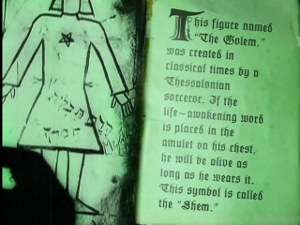
The original legend is our source for most of the conventional wisdom regarding golems. After all, what else was Adam? Since Rabbis strive in all things to move closer to God it only makes sense (in the context of this particular mythology) for them to pick up a few super powers along the way…including the power to create life. But as we are imperfect beings created in the image of Jehovah, so too are our creations destined to be imperfect images of us. It’s like Xeroxing a Xerox: something’s always lost in translation. That’s why golems inevitably go insane, occasionally growing in size as well as malevolence, becoming true daikaiju centuries before the first Godzilla movie.
Sadly, such awesomeness is beyond the scope of this film. But How He Came Into the World makes up for it by being awesome in a different way. According to this film, reanimating a golem requires one procure the Secret Word from the demon Astaroth. You summon Astaroth by putting on your magic chef’s hat, doing the required Magic Dance, and drawing a circle of fiery protection (for you) on the floor. The demon Astaroth is little more than a floating head on a string with smoke shoot out of its mouth…but it’s one damned creepy bastard of a floating head on a string, all the moreso when its smoke spells out the Secret Word: “aemhet.” Write the Secret Word down on a piece of paper, place it in an amulet, and stick the amulet to the golem’s chest. Voila.
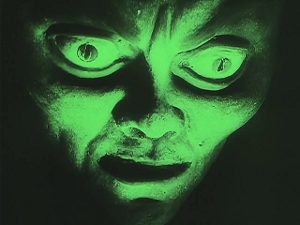
At this point, I started wondering what ignorant hick originally told Paul Wegener this story. Was he drunk when he heard it? What’s with all this demonic bullshit? Why did no on working on this – a movie that goes out of its way to at least appear sympathetic to its protagonist and his community – see how throwing in the demon Astaroth might reinforce negative stereotypes about Jews being into “black” magic? Besides, everybody with any sense knows the Secret Word (“emet“) is the Hebrew word for “truth” (and/or “reality”) and is available in any good dictionary, no demonic conjuring required.

But then the film’d have no excuse to save its money shots until the golem actually comes into the world. That’s our director in that bowl cut head appliance and what must’ve been a ton of body paint. His performance reminds me of those mimes who pretend to be statues and used to be all over My Fair City’s downtown shopping district, all stiff limbs and sudden, jerky gestures. Gestures that a young Boris Karloff may or may not have studied in preparation for a certain star-making role eleven years later. Who knows? I’m just putting that out there.
Much to the surprise of Miriam and his assistant, Famulus (Ernst Deutsch), the golem becomes Rabbi Low’s new gofer-er. Wood chopping, grocery shopping, it’s all the same. Frees up time for Famulus to study the real important stuff…like Miriam, whom he’s had a crush on All This Time. Wouldn’t you? Good thing the Old Man’s leaving for the Rose Festival…and taking his creepy new pet with him. This also means Sir Florian will have a perfect excuse to slip away from the castle and into Miriam’s arms.
This Golem‘s divides itself into five chapters. The first two are pure set-up, and it’s great set-up, if a bit meandering. Things begin to cook at the Rose Festival, where everything (from the sets to the score) practically screams that This Cannot End Well For Anyone. The golem, presaging countless movie-robots to follow, has begun to develop somewhat through all this interpersonal interaction, but as in the case of over half those robots, this may or may not be a Good Thing. Especially not with the idle rich poking at it.
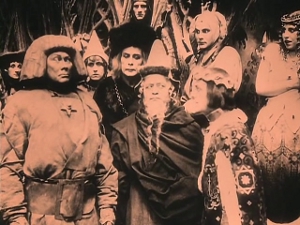
The Emperor’s Court is shocked and pleased with the golem, and His Imperial Majesty calls for further magical demonstrations. Rabbi Low obliges, creating some form of magic hologram to show off a presentation of Famous Jews Throughout the Ages. He only asks for complete silence during the production “to prevent a terrible disaster.” All goes well until the Wandering Jew comes on “screen” and the court jester gets His Imperial Majesty going. So of course the rest of the sycophantic lackeys have to laugh too, and probably have private contests to see who can out-laugh the other. This causes the projection to explode, literally bringing the house down. Only last-minute golem intervention saves Luhois’ heirs from having to haul his ass down to Rome for a Papal coronation ceremony. Grateful, the Emperor reverses his expulsion decree.
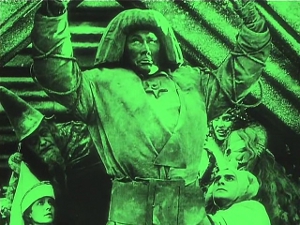
Jubilant, Rabbi Low and the golem return home, though the Rabbi makes it more of a pit stop on his way to the official celebrations at Temple. This would be the end of some films, but we were promised a golem rampage. How He Came Into the World delivers, and it’s spectacular, though budget and special effects limitations of the time (the German film industry wasn’t exactly flush with cash in the 20s) keep most of it off screen. In their place, we get to see Paul Wegener make some amazing facial expressions as the demon Astaroth begins to exert its evil influence over the golem.
Rabbi Low removes its amulet before leaving for Temple…but for some reason he forgets to tell Famulus about the goelm’s recent attempt on his life. A quick, “Hey, buddy – don’t reactivate the goelm. I think it might be turning evil” would’ve saved a lot of heartache…but, if it had, the star’s prophecy would never have come true. They were right though: disaster was inevitable, brought about by the very man who sought to prevent it. And that’s too bad. Hell, it’s downright tragic. But the tragedy of Rabbi Low is less acute than that of Victor Frankenstein for a variety of reasons.
Topping the list, we have the whole demon thing, unnecessarily complicating things. It’s like the “abnormal brain” in James Whale’s Frankenstein, missing the entire moral point of the story. This is all about the folly of tampering in God‘s domain, not Astaroth’s…whoever the hell Astaroth is…must be one of those third rate, grifter demons, duping yutzes out of their souls in exchange for free information. The kind of asshole who ‘ports out of ouija boards just to fuck with college freshmen. Of course, Rabbi Low could’ve avoided all of this through a simple step most modern magical practitioners take if they’re worth their salt. It’s called “reading the entire instruction manual before you begin.”
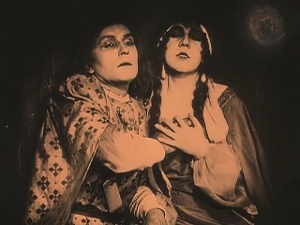
Apart from that little hiccup in characterization, there’s a lot to recommend in this film for horror fans, fans of the Silents, or movie fans in general. The performances are universally excellent, cutting the need for intertitles down to the absolute minimum. You really can get everything out of these people and their body language. Acting is reacting, but that’s especially true with pantomime. Stand out scenes include the one where Florian catches sight of Miriam for the first time. Hey, who’s the babe? The Rabbi’s daughter. Dude…I think I just creamed my pantaloons. Then there’s the scene where Famulus catches Rabbi Low emerging from the Basement Lab. What the blood fuck are you doing down there? Um…yeah…see…there’s this…thing…and I could really use your help at this point. I’m about to shake down a demon. The golem’s various “gone psycho” expressions deserve their own instructional course. And the central performance by Albert Steinrück holds the whole thing together. Given he created the golem, Rabbi Low’s more or less responsible for a film’s worth of death and destruction…but thanks to Albert Steinrück, I never side against him. He really does come off as a weary old patriarch, trying to do the best he can with not much more than a nightmare city.
And as with most German Expressionism, the sets are their own type of star, deserving of their own acclaim. They come to us from architect Hans Poelzig, who went absolutely mad for this job and produced madcapped results. These are the kinds of sets H.P. Lovecraft’s protagonists dreamed of, where impossible geometry meets subtly off-putting twists on the mundane. Made the most of by Wegener’s direction, which completes the illusion of a medieval ghetto…if one from an alternate dimension where architects are all insane. Even outside the sets, some of the compositions in this film are stunning enough to make Ingmar Bergman weep.
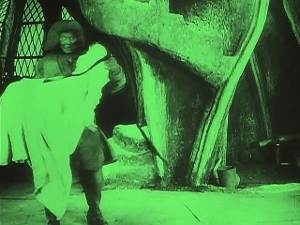
Is it a little slow? Yes. The Five Act structure’s not an easy one to pull off. Even Shakespeare fumbled a few of those balls before he reached the End Zone. Is it a little wishy-washy about the moral underpinnings of its own narrative? Sure, but I’ve seen worse. Is it worth your time to find? Hell yes. No matter what name you find it under, it’s the oldest surviving Frankenstein story we have on film, and for that alone it should be famous.
Is it good enough to tie your friends to chairs and force them to watch it, Clockwork Orange style? What am I, a Rabbi? They’re your friends; you figure that part out. Me, I loved it, so you can probably guess my plans. They don’t involve a single demon, so you’re mostly safe…for now.
![]()
![]()
![]()
![]()
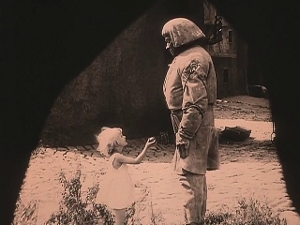

Caught this-has it really been nearly over 15 years?-ages ago at an art theater in Hartford, accompanied by a guy on seven different kinds of guitars. He was great, and I really enjoyed the film-but I discover upon reading your review that I barely remember it! Clearly it’s time for a revisit.
Not sure if you’re kidding or not about Astaroth, but he’s definitely an actual figure in medieval magical belief systems. Not so sure about the Jewish ones, but maybe this is some Christianized version of the tale that has to include a demon.
Indubitably, on both counts. There’s some definite Adaption Decay setting in here, and everyone should revisit this film…or visit it for the first time. I almost missed it myself until a Twitter conversation in the wake of the Nosferatu review jogged my memory. It doesn’t get nearly the amount of love or press that Murnau’s film gets, and Caligari is one of the most over-reviewed movies on the internet. So here we are.
Wow… And all this time I thought Astaroth was simply that creampuff from the SoulCalibur series–the one with the giant axe who had all the size (and speed) of a tree.
That’s one joke I shouldn’t have missed. That clicking sound you hear is my fighting game street cred reduing itself by -12. Obviously, this would call for more Mortal Kombat if my Xbox hadn’t died on me, like they do.
I saw this a few years ago at the Seattle Symphony. They have Silent Movie Mondays where they show an old silent and provide musical accompaniment. For THE GOLEM, they had a guy on an organ providing both the music and the sound effects. It was brilliant and fit the movie perfectly. I almost don’t want to watch the movie again because I’m afraid that any recorded soundtrack will pale next to the organist’s performance.
Just be sure to avoid the one Black Francis put together in 2008.
Hey and I saw this at Shimer back in 1964. What a good memory you’ve called up. Thanks.
You’re welcome. We aim to please.
I’ve never seen, or heard of this movie, but when I saw the picture I was immediately reminded of a segment in a Simpsons Treehouse of Horror, with the golem played by the voice of Richard Lewis. I thought the designs were rather unusual, but would have never guessed they came from an old silent movie, or at least the same thing that the old silent movie drew from.
That’d be the middle segment of 2006’s Treehouse of Horror XVII, should anyone be interested in tracking it down.
Oddly enough, the episode’s more faithful to traditional Golem mythology than this film, with the Golem taking orders from slips of paper placed in its mouth, rather than the Star of David medallion on its chest.